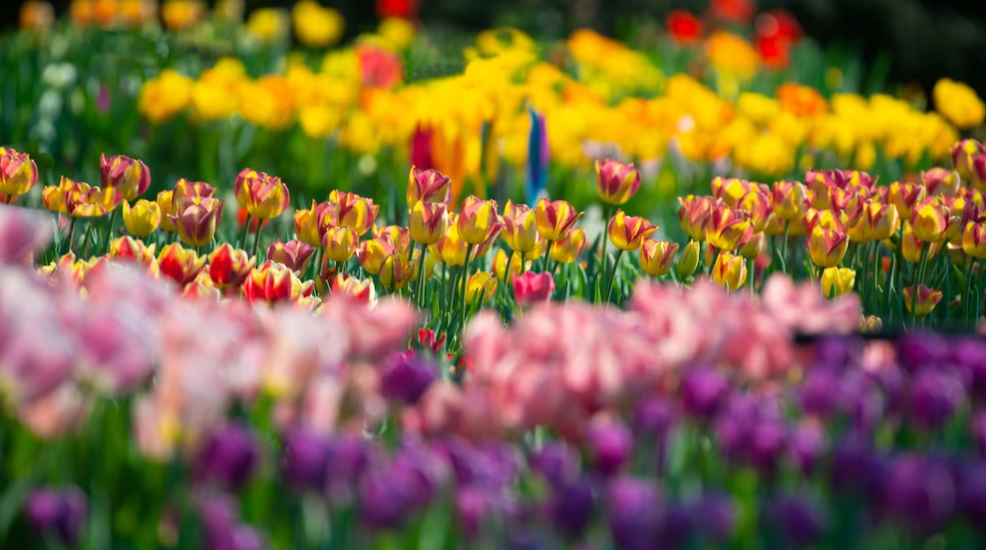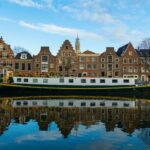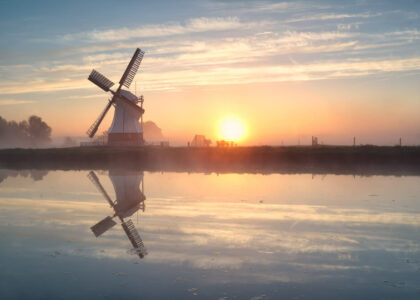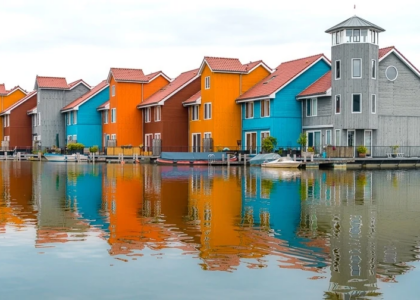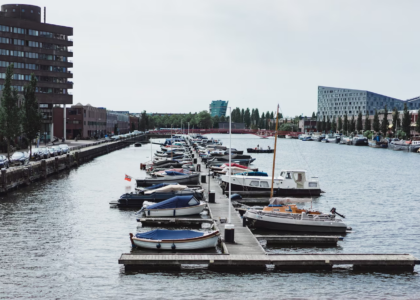Bicycles, cheese, and tulips — these are just a few of the remarkable elements that have made the Netherlands renowned worldwide. After spending a mere couple of nights in the Netherlands during our summer vacation, it became abundantly clear that we were compelled to return for further escapades! In the meantime, all we can do is share what we have discovered thus far about this captivating country. Hence, in this blog post, we will delve into the myriad of incredible aspects for which the Netherlands is widely recognized. Hopefully, this will provide you with a glimpse of the delights that await you on your next journey.
The Netherlands is a cheese lover’s paradise
When it comes to cheese, the Netherlands takes the spotlight. If you have a fondness for cheese, then this country is an ideal destination for you. It boasts a wide array of exquisite cheeses that will tantalize your taste buds.
Among the Dutch cheese varieties, you’ll find Edam, Maasdam, Beemster, Old Amsterdam, Prima Donna, and numerous others. However, the most renowned cheese originating from the Netherlands is undoubtedly Gouda. This delectable cheese has gained immense popularity worldwide—chances are, you’ve savored its flavors before.
Gouda delights the palate with its creamy and mild taste when young, while maturing into a more robust and firm texture. Its well-deserved status as a global favorite is a testament to its irresistible qualities.
While exploring the Netherlands, be sure to visit the numerous cheese shops scattered throughout the country. Even if you’re not particularly fond of cheese, stepping into these shops will overwhelm your senses with the delightful aroma and vibrant yellow hues of the cheese wheels.
Netherlands’ Floral Dominance: Leading the World in Flower Exports
Did you know that the Netherlands holds the prestigious title of being the world’s largest exporter of cut/bouquet flowers? It’s an impressive feat, considering the abundance of flowers produced in this country. Among them, the tulip stands out as the most renowned.
When spring arrives, particularly in mid-April, the Netherlands unveils its breathtaking tulip fields, captivating visitors from near and far.
Interestingly, the tulip is not indigenous to the Netherlands. It was introduced from Turkey during the 16th century, but swiftly gained popularity and became a highly sought-after plant. In fact, the demand for tulips reached such unprecedented heights in the 17th century that a phenomenon known as “Tulip mania” emerged. During this period, tulips were in such high demand that the value of a rare tulip bulb purportedly surpassed that of gold!
The Netherlands’ flourishing tulip industry and its historical fascination with these exquisite flowers make it a captivating destination for flower enthusiasts and history buffs alike.
The Netherlands’ Own Heineken: A Global Beer Powerhouse
Heineken, the renowned Dutch beer, has earned its place as one of the Netherlands’ most iconic exports. Distributed in numerous countries worldwide, it proudly holds the position of the world’s second largest beer company.
Back in 1973, Gerard Heineken, the namesake behind the beer, established his brewery in Amsterdam. The lager quickly won the hearts of Amsterdam’s residents, catapulting it into popularity and propelling the company’s rapid expansion.
When you visit the Netherlands, be sure to savor a refreshing Heineken. It’s readily available in most bars and restaurants, offering you the perfect opportunity to indulge in this national treasure. For an added delight, we suggest pairing your brew with some delectable Dutch Gouda cheese—it’s a match made in heaven!
Embracing its Flat Lands and Preparing for the Future
While the Netherlands may not claim the title of the world’s flattest country, it holds the distinction of being the flattest nation in Europe. In fact, the very name of the country, “The Netherlands,” reflects its low-lying nature as it translates to “the lower lands.”
As you traverse the country, you will quickly realize the extent of its flatness. While driving on the highways, vast expanses of flat plains will greet your eyes, stretching as far as they can see. It is a remarkable experience to behold.
Now, one may question the significance of this characteristic, especially in light of the challenges posed by rising sea levels due to global warming. However, the flat lands of the Netherlands offer numerous advantages. The fertile plains are exceptionally well-suited for agriculture, supporting a thriving farming industry. Additionally, the low-lying nature of the country has resulted in the creation of intricate canal systems, which add to the country’s charm. Some of these canals even provide a unique living space for residents in the form of houseboats. Moreover, the Netherlands has been actively formulating plans to address the impacts of rising sea levels, demonstrating their commitment to tackling the challenges posed by climate change.
In essence, the Netherlands embraces its flat lands, celebrating the opportunities they bring while proactively preparing for the future to ensure a sustainable and resilient nation.
The Netherlands: Home to the World’s Tallest Population
The Netherlands has gained worldwide recognition for its exceptionally tall population. Over the years, the Dutch have consistently held the title of the tallest people on the planet.
The remarkable stature of the Dutch can be attributed to several factors, including a nutrient-rich diet. Height often serves as a marker of a nation’s overall health, and in this regard, the Dutch people boast exceptional well-being.
As of 2019, the average height of Dutch men stood at an impressive 182.53 cm, while Dutch women measured an average of 168.72 cm. Combining these figures, the overall average height of a Dutch person reaches 175.62 cm, solidifying the Netherlands’ position as the tallest nation in the world.
Netherlands’ Rich Heritage: Over 1000 Historical Windmills
The quintessential image of the Netherlands often includes the iconic presence of old, traditional windmills.
These windmills held immense significance for the Netherlands as they played a vital role in draining water from the low-lying fields. By harnessing the power of the wind, these ingenious structures enabled agricultural activities to thrive in areas situated below sea level.
While windmills also served various industrial purposes such as grain grinding, their primary function was unquestionably the drainage of fields.
During their peak, the Netherlands boasted a staggering number of over 10,000 windmills scattered across the country. However, today, only a little over 1000 of these magnificent structures remain. Many of these surviving windmills carry a rich historical legacy, standing as witnesses to centuries of progress and change. Thus, it is highly recommended to seize the opportunity to visit one of these remarkable windmills during your trip to the Netherlands.
Exploring these historical windmills provides a unique glimpse into the country’s past and showcases the remarkable engineering prowess and ingenuity of its inhabitants. Prepare to be captivated by the beauty and heritage that these windmills embody, leaving an indelible mark on your Dutch experience.
Exploring the Tradition of Wooden Clogs in the Netherlands
During our visit to Utrecht, we had an unforgettable encounter. As we strolled through the city, the sound of horse hooves caught our attention, only to discover that it was a gentleman walking in wooden clogs. It was a unique and rare sight, as witnessing someone wearing wooden shoes is a rarity in the Netherlands.
Nonetheless, the Netherlands continues to be renowned for its association with wooden clogs. These iconic shoes have a history dating back to the 13th century, serving as protective footwear for farmers, fishermen, and factory workers.
Although the chances of spotting a local wearing wooden clogs are slim, you can easily find an array of vibrant wooden shoes in tourist shops across the country. Why not indulge in the experience yourself and try them on? It’s a delightful way to connect with this traditional Dutch symbol.
The Netherlands and the Birth of the First Stock Market
While international trade flourished in Belgium during the 15th century, it was the Netherlands that revolutionized the world of finance by establishing the very first modern stock market.
In the year 1611, Amsterdam became the birthplace of the Dutch East India Company, which marked the advent of public trading of company shares. This momentous development laid the foundation for the modern stock market as we know it today. Subsequently, the United States followed suit by establishing stock exchanges in New York and Philadelphia. Nevertheless, the distinction of hosting the world’s inaugural stock market belongs rightfully to the Netherlands.
The Netherlands’ groundbreaking achievement in creating a formalized platform for buying and selling company stocks paved the way for global financial markets and influenced the evolution of economic systems worldwide. This noteworthy milestone underscores the Dutch nation’s reputation as a trailblazer in financial innovation and highlights its enduring legacy in shaping the modern financial landscape.
A Hub of International Courts and Administrative Power
The Hague, or “Haag” in Dutch, is renowned as the location of prominent international courts in the Netherlands. It serves as the distinguished home to both the International Court of Justice and the International Criminal Court.
The International Court of Justice finds its residence in the magnificent Peace Palace. Functioning as a branch of the United Nations, this court plays a pivotal role in settling international disputes and providing legal opinions on global matters.
In contrast, the International Criminal Court operates with a distinct purpose. Empowered to prosecute individuals for grave offenses, including genocide, war crimes, and human rights violations, this court serves as a beacon of justice on the international stage.
Beyond its status as a hub for international courts, The Hague holds significance as the administrative center of the Netherlands. While Amsterdam claims the title of the capital, The Hague proudly serves as the seat of the Dutch government, exemplifying its importance in national governance.
Discovering the Unique Snack Walls of the Netherlands
As a traveler from Denmark, Cecilie was pleasantly surprised to encounter a distinct culinary phenomenon during her explorations in the Netherlands—the snack walls, also known as “snack muur.”
The snack walls are a fascinating concept that Cecilie hadn’t come across anywhere else in the world. Essentially, they consist of walls where patrons can insert a small amount of money, typically around €2, in exchange for a warm frituur snack. The array of options available is simply delightful, featuring delectable treats like kroket, burgers, sausages, bitterballs, and much more.
For Cecilie, these snack walls became an absolute highlight of her Dutch experience. She relished the opportunity to indulge in a quick and delicious snack while traversing the Netherlands. The presence of snack walls was a unique feature that she found the country to be renowned for, setting it apart from other destinations.
These snack walls embody the Dutch penchant for culinary innovation, offering both locals and visitors an enjoyable way to savor tasty delights on the go. So, if you find yourself in the Netherlands, be sure to keep an eye out for these distinctive snack walls and treat yourself to a memorable snack experience unlike any other.
Unique Culture of ‘Coffee’ Shops in the Netherlands
When discussing the Netherlands’ distinctive features, it would be remiss not to mention the renowned ‘coffee’ shops. However, we’re not referring to your typical espresso or cappuccino establishments. Instead, we’re delving into the small establishments scattered throughout the country where marijuana can be legally purchased.
While the Netherlands has adopted a policy of drug legalization, we want to emphasize that we do not endorse or discourage anyone from partaking in these substances. It remains a personal choice. Nevertheless, we appreciate the transparency of having such establishments openly available.
Having traveled to countries where encounters with shady dealers in dimly lit alleys were unsettling, we personally appreciate the notion of keeping the drug trade legalized and above ground. However, this viewpoint is purely subjective and open to individual interpretation.
A Bicycle Paradise with More Bikes Than People
When it comes to the Netherlands, one cannot overlook its long-standing reputation for bicycles.
In fact, the number of bicycles surpasses the country’s population. According to the official government website, while there are 17 million people in the Netherlands, an astonishing 22.8 million bicycles can be found!
Cycling has become an integral part of Dutch culture, leading to substantial investments in excellent bicycle infrastructure throughout the country. This commitment has made the Netherlands one of the finest and safest destinations in the world for bike enthusiasts to embark on their cycling vacations.
The Netherlands Ranks as the World’s Best Non-Native English Speakers
When venturing through the Netherlands, communication hurdles will be few and far between, as it’s rare to encounter someone who doesn’t speak English. However, a basic knowledge of English on your part will be beneficial.
According to the latest available data from 2019, the Netherlands received the prestigious accolade of being the world’s leading country in terms of English proficiency as a second language.
During our own journey, we delighted in discovering that this reputation holds true. Seeking assistance and navigating our way around became effortless. The Dutch mastery of English is truly commendable, as it enhances the travel experience for visitors like us. It’s undoubtedly a remarkable attribute for a country to be known for, making our adventures much more accessible and enjoyable.
So, when planning a trip to the Netherlands, rest assured that effective communication in English will likely be a breeze. The country’s impressive English-speaking abilities create an environment that is welcoming and convenient for travelers from around the world.
Endearing World of Miffy: A Creation by Dutch Artist Dick Bruna
During our stroll through the charming streets of Utrecht, we stumbled upon a museum solely dedicated to Miffy, the beloved fictional character. Recognizable by her iconic red dress, Miffy, or “Nijntje” in Dutch, quickly revealed herself as a quintessentially Dutch creation.
In 1955, the talented Dutch artist Dick Bruna brought Miffy to life through his first book. As Miffy’s popularity soared, numerous subsequent books, a television series, and even a movie followed suit.
While Miffy’s adventures didn’t personally grace my childhood memories, Glenn certainly recalls the endearing tales of this little white rabbit. It seems that Miffy has captured the hearts of many around the world. How about you? Did you have the pleasure of experiencing Miffy’s enchanting world during your own childhood?
The Majestic Dom Tower: Netherlands’ Tallest Church Tower
One of the Netherlands’ most celebrated historical landmarks is the Dom Tower in Utrecht, also referred to as “Domtoren” in Dutch.
Construction of this iconic church tower commenced in 1321, and after 61 years of meticulous work, it was finally completed. The Dom Tower stands as a testament to the enduring quality of its architecture, having withstood the test of time for centuries.
Soaring to a height of 112 meters, the Dom Tower proudly claims the title of the tallest church tower in the entirety of the Netherlands. Its commanding presence can be easily spotted from various vantage points throughout the city of Utrecht.
Visiting the Dom Tower is a worthwhile experience during your trip to the Netherlands. However, it’s important to note that the tower is currently undergoing an extensive restoration project scheduled to conclude in 2024. Remarkably, setting up the scaffolding alone took an entire year! Whether adorned in scaffolding or not, ascending this iconic tower remains a remarkable and memorable adventure.
Legacy of Vincent van Gogh
When discussing the Netherlands’ renowned contributions to the world, one cannot overlook the extraordinary talent of Vincent van Gogh. Undoubtedly, he stands as one of the most iconic and famous painters in history, solidifying his place among the remarkable things for which the Netherlands is esteemed.
While Van Gogh’s artistic genius wasn’t fully appreciated or acknowledged during his lifetime, his works have since garnered immense recognition. A post-impressionist painter, he created over 2,000 artworks in a mere decade, with more than 800 of them being stunning oil paintings.
Born in Zundert, the Netherlands, in 1853, Van Gogh’s life tragically ended in France in 1890 when he took his own life after grappling with depression and poverty. Often referred to as a “tortured artist,” his remarkable paintings now receive the admiration and acclaim they truly deserve.
Van Gogh’s artistic legacy continues to captivate audiences worldwide, as his masterpieces showcase his unique and emotionally charged style. His innovative use of color and brushwork, along with his ability to evoke deep emotions, have left an indelible mark on the art world.
Today, museums around the globe proudly display Van Gogh’s artworks, allowing art enthusiasts to immerse themselves in his extraordinary talent and delve into the depths of his expressive creations. The Netherlands, rightfully proud of its association with this exceptional painter, cherishes Van Gogh as a national treasure, celebrating his enduring impact on the world of art.
Rembrandt: A Renowned Dutch Master
Renowned as one of the most celebrated painters hailing from the Netherlands, Rembrandt Harmenszoon van Rijn, commonly known as “Rembrandt,” left an indelible mark on the art world.
Born in Leiden in 1606, Rembrandt belonged to a distinct era and artistic movement compared to Van Gogh. His work emerged during the Dutch Golden Age, characterized by the baroque style, and was distinguished by his masterful manipulation of light and shadow.
Among his extensive portfolio, notable masterpieces include “The Night Watch,” “The Storm on the Sea of Galilee,” and “The Anatomy Lesson of Dr. Nicolaes Tulp.” Rembrandt’s exceptional talent in portraiture is evident through his captivating self-portraits and depictions of individuals throughout his career.
De Haar Castle: The Largest Castle in the Netherlands
De Haar Castle stands as one of the Netherlands’ most renowned castles and prominent architectural marvels.
Situated just a short 20-kilometer drive from Utrecht, the castle boasts a stunning location within a vast park adorned with flourishing flowers, lush forests, serene ponds, picturesque bridges, and graceful deer. Yet, De Haar’s allure extends far beyond its scenic surroundings; it is steeped in rich history, with its origins tracing back to the 13th century.
Whether you seek a day of leisure in a breathtaking park or aspire to explore one of the Netherlands’ most iconic castles, a visit to De Haar is a must. It promises an experience that combines natural beauty with historical significance, leaving an indelible impression on all who venture within its storied walls.
Jenever: The Distinctive Liquor of the Netherlands
The Netherlands, along with Belgium and certain regions of Northern France, is renowned for its distinctive spirit called Jenever. This traditional liquor holds such significance that it received an official AOC (Appellation d’origine contrôlée) designation in 2008, stipulating that it can only be produced in these specific areas.
Historically, Jenever was crafted by distilling malt wine to a strength of 50 percent and then infusing it with juniper berries to enhance its flavor. However, the distillation process has evolved over time, incorporating various steps to achieve a more refined and well-rounded taste.
Jenever is traditionally served in small glasses, akin to shot glasses, although it is intended to be enjoyed slowly, sip by sip. Its rich cultural heritage and unique character make Jenever a cherished part of the Netherlands’ drinking culture.
Exploring the Iconic Canals of the Netherlands
The Netherlands is globally renowned for its captivating canals, which form an integral part of the country’s identity. These enchanting waterways can be found winding their way through numerous cities, with Amsterdam standing out as a crown jewel of canal splendor. In fact, Amsterdam’s canal network has been granted UNESCO World Heritage status due to its exceptional significance.
Did you know that Amsterdam boasts more canals than Venice? With a remarkable 165 canals, Amsterdam surpasses Venice’s count of 150 canals, solidifying its reputation as a canal-laden marvel.
The prevalence of canals in the Netherlands has also given rise to an abundance of houseboats, ranging from modern designs to historic vessels. Witnessing the unique lifestyle of people living on water is truly captivating, showcasing the ingenuity and adaptability of the Dutch people.
The canals of the Netherlands offer a glimpse into the country’s rich history, architectural beauty, and innovative spirit, leaving visitors in awe of their enchanting allure.
Dual Delight: Two Types of Festive Figures in the Netherlands
In the Netherlands, a unique Christmas tradition unfolds, featuring not just one, but two beloved figures. Allow me to introduce you to Sinterklaas, a cherished character celebrated on the 5th and 6th of December, deeply ingrained in Dutch and Belgian culture.
Sinterklaas draws inspiration from Saint Nicholas, a Greek bishop. Adorned in a red bishop hat, sporting a long white beard, and mounted on a majestic white horse, Sinterklaas carries a book chronicling the deeds of both the well-behaved and the mischievous children. He delights in delivering gifts to the young ones.
While similarities between Sinterklaas and Santa Claus are evident, it is important to note that Sinterklaas holds religious significance as a revered figure. This sets him apart from the secular Santa Claus.
Have you encountered the festive legend of Sinterklaas before? Share your thoughts and experiences in the comments below. Regardless, the prospect of receiving Christmas presents twice in December is undoubtedly a joyful occurrence!
The Netherlands: Beyond Holland’s Borders
In Denmark, like in many other places, the Netherlands is commonly referred to as “Holland.” However, it’s important to note that Holland is just one of the provinces within the country.
In 2019, the Dutch government made a deliberate effort to rebrand the nation as “The Netherlands” instead of “Holland.” This initiative aimed to promote a more accurate representation of the entire country, rather than focusing solely on one province. The name change was implemented in international sporting and cultural events, and the tourism board emphasized using “The Netherlands” to describe the nation.
While foreign visitors and many people still use the term “Holland” out of familiarity, the Dutch government’s intentions to shift the focus to “The Netherlands” reflect a desire for a more comprehensive representation. Over time, perceptions and naming conventions may gradually align with this broader perspective.
Amsterdam: The Iconic Gem of the Netherlands
Among the numerous remarkable cities in the Netherlands, none shines brighter than the illustrious Amsterdam. As the capital and largest city of the country, Amsterdam captivates visitors with its enchanting UNESCO-listed canal system, an abundance of enlightening museums, and its renowned coffee shop culture.
This vibrant city offers an ideal destination for a memorable long weekend. Immerse yourself in the leisurely ambiance, basking in the sunlight as you navigate the picturesque canals. Meanwhile, indulge in the rich cultural offerings found within the city’s diverse array of museums. Amsterdam truly has it all.
We hold a deep affection for this remarkable city and eagerly anticipate our next visit, eager to experience more of Amsterdam’s captivating charm.
Embracing Orange: The National Color of the Netherlands
The Netherlands proudly associates itself with the vibrant color orange, evident in the spirited support of their national football team, adorned in orange attire, while passionate fans create a sea of orange in the stands.
But why do the Dutch celebrate with orange when their national flag consists of red, white, and blue?
The significance of orange traces back to the 16th century and William of Orange, considered the founding father of the Netherlands. This influential figure bestowed his name upon the Royal Dutch Family, officially known as “Orange-Nassau.” As a result, orange became the color symbolizing the Royal Family and their connection to Dutch heritage.
Curiously, the Dutch flag originally featured orange, white, and blue. The reason for the transition from orange to red in the current flag remains unknown. Nevertheless, regardless of its presence on the flag, orange remains an immensely cherished color, deeply intertwined with the Kingdom of the Netherlands and its cultural identity.
Koningsdag: The Joyous Celebration in the Netherlands
One of the most iconic celebrations in the Netherlands is “Koningsdag,” also known as “King’s Day.”
Koningsdag is a national holiday dedicated to honoring the birthday of the reigning monarch, currently Dutch King Willem Alexander, whose birthday falls on April 27th.
During this vibrant celebration, the streets come alive with a sea of orange, the national color of the Netherlands. People enthusiastically participate by setting up small market stands, engaging in lively festivities, and enjoying the convivial atmosphere with ample amounts of merriment and libations.
The images captured during Koningsdag depict a spectacle of joy and excitement. It is an event that holds great appeal, and we hold aspirations to experience this unique celebration firsthand someday. As a visitor, you can easily embrace the spirit of the occasion by donning orange attire, allowing you to immerse yourself fully while also blending in as a tourist.
Conclusion
The Netherlands has earned its global reputation for a multitude of remarkable achievements and cultural contributions. From the famous windmills and historic tulip fields to the thriving cheese and beer industries, the country offers a diverse tapestry of attractions that captivate visitors from near and far. With its flat lands, innovative snack walls, fluent English speakers, and the enduring legacy of iconic painters like Van Gogh, the Netherlands continues to enchant and inspire, leaving an indelible mark on those fortunate enough to experience its wonders.

